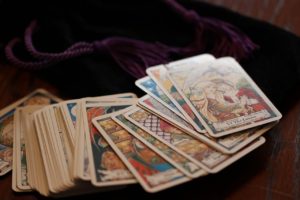A Darker Shade of Magic is an extraordinarily fun book.
V.E. Schwab crafts an exceedingly enjoyable, vivid world whose sheer concept feels pulled from the wishes of my younger, Victorian-lit-and-anime-loving-self. Her magic system in this novel, while not entirely original in its uses, is original where it counts: in its cultural significance and the way it interacts with the world. Besides: it allows her to write fights that seem pulled straight from Avatar: The Last Airbender. Meanwhile, Schwab’s characters have enough depth and personality to keep you interested and make you care, her plot leaves no time wasted, and I found myself relentlessly turning pages.
The book’s downsides are kind of strange… mostly because, after reading the second and third books in the series, much of them go away. The magic is greatly fleshed out in the rest of the series, becoming quite original. Occasional moments in this novel where the worldbuilding feels superficial or seems like it’s meant to create a fantasy allegory for something present in our world that the plot needed make perfect sense. Even my biggest complaint for this book, that the characters were a little more flat or archetypal than I’d prefer, evaporates entirely after the second novel.
In all, I don’t think these “downsides” were anything other than a stylistic choice and a necessity of kicking off a brand-new series for a writer that writes an absurd amount of work every year.
Seriously. Writers: take a look at how many books Schwab’s published, then deal with the mental battle between being impressed and feeling overwhelmed.
Anyway, Schwab had a story to start, here. It was a great start, too, one that dragged me into the world and made me want to read more. She gets you invested in the characters and world through a fun, but emotionally engaging story packed with enjoyable—if archetypal—characters, great worldbuilding, and a unique aesthetic. Then, she spends the next two books developing all this into an amazing tale full of richly fleshed-out, complicated characters, a plot full of twists and turns, and a conflict that balances epic scale and stakes, and personal, emotional interest.
But, my goal in these reviews is usually to talk about something writers can learn from a work. For that? Well, I think A Darker Shade of Magic is a great example of how to interweave conflicts to keep a story moving forward.
While authors like Alice Walker weave together disparate conflicts to keep momentum up, as though pulling several different threads (which I’ve written about before), Schwab layers obstacles in a more focused fashion, in order to keep the same story constantly moving forward.
There are two major ways she accomplishes this: first off, she’s not shy about jumping away from the primary narrators to different characters. Do not underestimate the value of this. V.E. Schwab said in a tweet, recently, that people aren’t interested in “what” your characters do… they’re interested in “why” they do it. Jumping from character to character allows her to utilize prose writing’s greatest strength; introspection. We get to see into her characters’ heads and understand why they act the way they do, which gets us much more invested. And Schwab is very good at getting us interested in them in a few short pages. She often does this by giving us specific, idiosyncratic details, like opening a chapter with “[character] was not an honest man.” Yes: it’s “telling,” not “showing,” but when you only have a few pages, it still makes a great impact.

This accomplishes one other goal, too; it gives us a different angle from which to view the main story, filling in blanks and opening up new avenues.
Now, with our interest in the characters established, Schwab uses these varied perspectives to do something important: ensure that she never closes one subplot or point of tension before opening another.
Take a small example: before Kell and Lila travel from Gray London to Red (thus, closing several subplots), the characters discuss the fact that this might not work. Kell is unsure if regular folk can travel between Londons these days. This produces some anxiety and tension; yes, they’re getting away from a temporary danger, but what are they going towards? Then, when Lila makes it through, another question is promptly asked: how did she make it through?
That’s not all, of course; after Lila and Kell step through, the narrative shifts to the lovable Barron. He doesn’t get much “screen time,” but it’s easy to like the guy. In the scene that follows, another plot thread is torn open that ties back to Lila, Kell, and the main story, and that is made so much more impactful by what we’ve gotten to know about these characters through Schwab’s bouncing around.
Most importantly, it provides another source of tension that now underscores the entire narrative, even as smaller subplots are resolved.
A Darker Shade of Magic never gives us a moment where there isn’t some kind of tension in the primary story getting readers to continue turning pages. Her method is an interesting contrast to Alice Walker. If Walker interweaves conflict “laterally,” relying on wholly different threads tied together mostly by the character’s relationship, Schwab layers conflict “linearly.”
It may come from a wide variety of places—the world, another character’s life or perspective—but each point of tension ties back, somehow, to the main story and the main character arcs; the battle against Holland and the black stone, Lila’s desire for adventure and fear of closeness, and Kell’s attempts to save his family and make up for his mistake. It makes the story pointed, focused, and fast-paced, while ensuring that there’s a nicely fleshed-out world still visible to the reader.
It’s a bit like a “cone;” all these subplots might tie back to a single story or arc, but they come from so many different angles that they give us a wide view of the story, characters, and world.
Try it in your own stories some time. You’ll be surprised by how quick they move!
Featured image courtesy of Negative Space!


